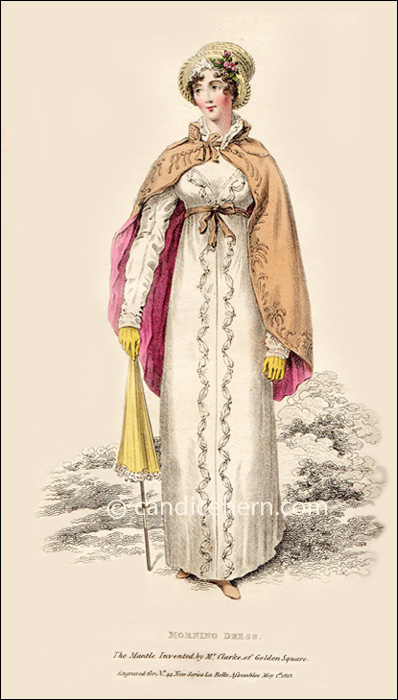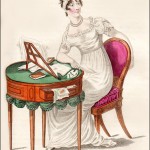This is clearly an outdoor morning dress, ie a morning walking dress.
The pelisse and spencer were the most popular forms of outer wear throughout the Regency period, but the mantle is also seen frequently in prints, in all seasons and in a variety of fabrics. It is a short form of cape, fastened in front, with no sleeves. I think the mantle shown here is a particularly beautiful one.
The print is described in the magazine as follows:
“Jaconet muslin high dress, made a walking length, and richly embroidered up the front, round the collar, and round the bottom of the sleeve, which is very long, and rather more loose than they have been worn. The embroider in front, as our readers will see by the Plate, is divided, and goes up the bosom in a slope on each side. Round cottage mantle of stone-coloured fine cloth, richly embroidered in a floss silk of the same colour, and lined with delicate pink. The form of the mantle, though simple, is very becoming; a high collar, and small round cape, finished with embroidery to correspond.–This elegant mantle was invented by Mr. Clarke, of Golden Square. A thatched straw hat, turned up in the front, and lined with satin in the same colour as the hat; it is ornamented with a small quilling of lace on one side, and pink rose on the other.–This fashionable hat is from the Manufactory of Millard, corner of Southampton street, Strand. Sandals and gloves of straw-coloured kid. Parasol to correspond, straw-colour shot with white, and trimmed with white silk fringe.”
Mr. Clarke, the “inventor” of the mantle, is mentioned in earlier issues of this magazine as the inventor of riding habits. Tailoring of certain pelisses and habits and other such masculine-styled garments had long been the purview of the male tailor, though by this time, female designers had broken that glass ceiling and were offering full-service dress-making and tailoring to their female clients. This is one of the last times Mr. Clarke is mentioned.








